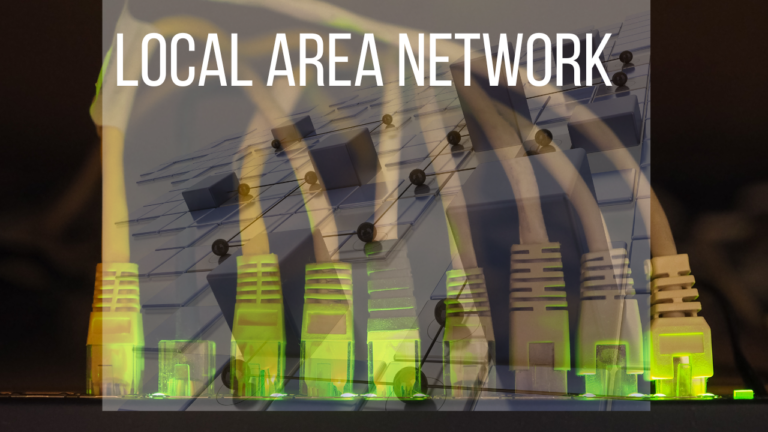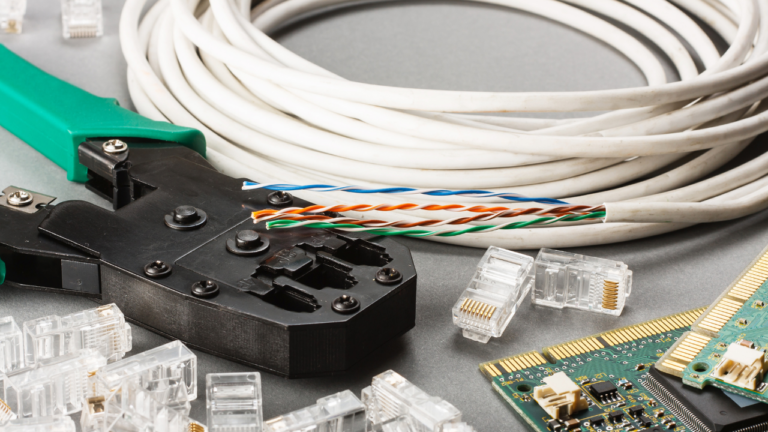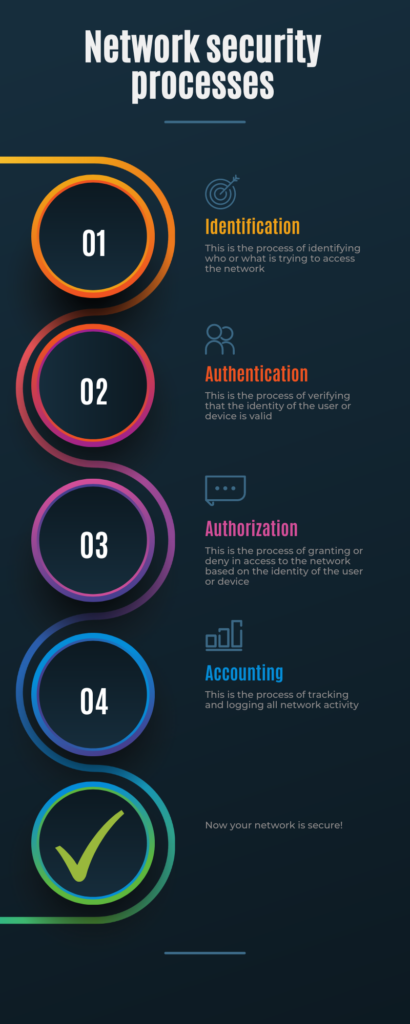IT Networking For Beginners

IT Networking For Beginners: Intro
In this article, we are going to discuss the basics of IT networking. We will cover topics such as network infrastructure, network devices, and network services. By the end of this article, you should have a good understanding of how IT networking works.
What Is A Computer Network?
A computer network is a group of computers that are connected to each other. The purpose of a computer network is to share data and resources. For example, you can use a computer network to share files, printers, and internet connection.
Types Of Computer Networks
There are 7 common types of computer networks:
A Local Area Network (LAN): is a group of computers that are connected to each other in a small area such as a home, office, or school.
Wide Area Network (WAN): A WAN is a larger network that can span multiple buildings or even countries.
Wireless Local Are Network (WLAN): A WLAN is a LAN that uses wireless technology to connect the devices.
Metropolitan Area Network (MAN): A MAN is a city-wide network.
Personal Area Network (PAN): A PAN is a network that connects personal devices such as computers, laptops, and smartphones.
Storage Area Network (SAN): A SAN is a network that is used to connect storage devices.
Virtual Private Network (VPN): A VPN is a private network that uses a public network ( such as the internet) to connect remote sites or users.

Networking Terminology
Here is a list of common terms used in Networking:
IP address: Every device on a network has a unique IP address. IP address is used to identify a device on a network. IP stands for Internet Protocol.
Nodes: A node is a device that is connected to a network. Examples of nodes include computers, printers, and routers.
Routers: A router is a device that forwards data packets between networks.
Switches: A switch is a device that connects multiple devices together on the same network. Switching allows for data to be sent only to the intended recipient.
Types of switching:
Circuit switching: In circuit switching, the connection between two devices is dedicated to that specific communication. Once the connection is established, it cannot be used by other devices.
Packet switching: In packet switching, data is divided into small packets. Each packet can take a different route to the destination. Packet switching is more efficient than circuit switching because it allows multiple devices to share the same network connection.
Message switching: Message switching is a type of packet switching that is used to send messages between computers.
Ports: Ports are used to connect devices to a network. Each device has multiple ports that can be used to connect to different types of networks.
Here is an analogy for ports: think of ports as the outlet in your home. You can use the same outlet to plug in a lamp, TV, or computer.
Network cable types
There are 4 common types of network cables:
Coaxial cable: Coaxial cable is a type of cable that is used for cable TV and internet. It is made of a copper core that is surrounded by an insulating material and a protective jacket.
Twisted pair cable: Twisted pair cable is a type of cable that is used for Ethernet networks. It is made of two copper wires that are twisted together. The twisting helps to reduce interference.
Fiber optic cable: Fiber optic cable is a type of cable that uses light to transmit data. It is made of a glass or plastic core that is surrounded by a cladding material.
Wireless: Wireless is a type of network that uses radio waves to transmit data. Wireless networks do not use physical cables to connect devices.

Topologies
There are 4 common network topologies:
Bus topology: In a bus topology, all of the devices are connected to a single cable.
Advantages:
– Easy to connect new devices
– Easy to troubleshoot
Disadvantages:
– If the main cable fails, the entire network goes down
– Performance decreases as more devices are added to the network
Star topology: In a star topology, all of the devices are connected to a central device.
Advantages:
– Easy to add and remove devices
– Easy to troubleshoot
– Each device has its own dedicated connection
Disadvantages:
– If the central device fails, the entire network goes down
Ring topology: In a ring topology, each device is connected to two other devices.
Advantages:
– Easy to troubleshoot
– Each device has its own dedicated connection
Disadvantages:
– If one device fails, the entire network goes down
– Performance decreases as more devices are added to the network
Mesh topology: In a mesh topology, each device is connected to every other device.
Advantages:
– Each device has its own dedicated connection
– Reliable
– No single point of failure
Disadvantages:
– More expensive than other topologies
– Difficult to troubleshoot
– Performance decreases as more devices are added to the network
3 Examples Of Computer Networks
Example 1: In an office setting, computers are connected to each other using a network. This network allows employees to share files and printers.
Example 2: A home network allows devices to connect to the internet and share data with each other.
Example 3: A mobile network is used to connect phones and other mobile devices to the internet and each other.
How Do Computer Networks Work With The Internet?
Computer networks connect devices to the internet so that they can communicate with each other. When you connect to the internet, your computer sends and receives data through the network. This data is sent in the form of packets. Each packet contains information about where it came from and where it is going. The packets are routed through the network to their destination.
Internet Service Providers (ISPs) provide the connection between computer networks and the internet. ISPs connect to computer networks through a process called peering. Peering is when two or more networks connect to each other so that they can exchange traffic. Traffic is the data that is sent between networks.
There are four types of ISP connections:
– Dial-up: A dial-up connection uses a phone line to connect to the internet. This is the slowest type of connection.
– DSL: A DSL connection uses a phone line to connect to the internet. This is a faster type of connection than dial-up.
– Cable: A cable connection uses a cable TV line to connect to the internet. This is a faster type of connection than DSL.
– Fiber: A fiber connection uses optical fibers to connect to the internet. This is the fastest type of connection.
Network Service Providers (NSPs) provide the connection between computer networks and the internet. NSPs connect to computer networks through a process called peering. Peering is when two or more networks connect to each other so that they can exchange traffic. Traffic is the data that is sent between networks.
There are four types of NSP connections:
– Dial-up: A dial-up connection uses a phone line to connect to the internet. This is the slowest type of connection.
– DSL: A DSL connection uses a phone line to connect to the internet. This is a faster type of connection than dial-up.
– Cable: A cable connection uses a cable TV line to connect to the internet. This is a faster type of connection than DSL.
– Fiber: A fiber connection uses optical fibers to connect to the internet. This is the fastest type of connection.

Computer Network Architecture
Computer network architecture is the way that computers are arranged in a network.
A peer-to-peer (P2P) architecture is a network architecture in which each device is both a client and a server. In a P2P network, there is no central server. Each device connects to another device on the network to share resources.
A client-server (C/S) architecture is a network architecture in which each device is either a client or a server. In a C/S network, there is a central server that provides services to clients. Clients connect to the server to access resources.
A three-tier architecture is a network architecture in which each device is either a client or a server. In a three-tier network, there are three types of devices:
– Clients: A client is a device that connects to a network.
– Servers: A server is a device that provides services to clients on a.
– Protocols: A protocol is a set of rules that govern how devices communicate on a network.
A mesh architecture is a network architecture in which each device is connected to every other device on the network. In a mesh network, there is no central server. Each device connects to every other device on the network to share resources.
A full mesh topology is a mesh architecture in which each device is connected to every other device on the network. In a full mesh topology, there is no central server. Each device connects to every other device on the network to share resources.
A partial mesh topology is a mesh architecture in which some devices are connected to every other device on the network, but not all devices are connected to all other devices. In a partial mesh topology, there is no central server. Some devices connect to every other device on the network, but not all devices connect to all other devices.
A wireless mesh network (WMN) is a mesh network that uses wireless technologies to connect devices. WMNs are often used in public spaces, such as parks and coffee shops, where it would be difficult to deploy a wired mesh network.
Using Load Balancers
Load balancers are devices that distribute traffic across a network. Load balancers improve performance by distributing traffic evenly across the devices on a network.
When to Use Load Balancers
Load balancers are often used in networks where there is a lot of traffic. For example, load balancers are often used in data centers and web farms.
How Load Balancers Work
Load balancers distribute traffic across a network by using a variety of algorithms. The most common algorithm is the round-robin algorithm.
The round-robin algorithm is a load-balancing algorithm that distributes traffic evenly across the devices on a network. The round-robin algorithm works by sending each new request to the next device in a list.
The round-robin algorithm is a simple algorithm that is easy to implement. However, the round-robin algorithm does not take into account the capacity of the devices on the network. As a result, the round-robin algorithm can sometimes cause devices to become overloaded.
For example, if there are three devices on a network, the round-robin algorithm will send the first request to the first device, the second request to the second device, and the third request to the third device. The fourth request will be sent to the first device, and so on.
To avoid this problem, some load balancers use more sophisticated algorithms, such as the least-connections algorithm.
The least-connections algorithm is a load-balancing algorithm that sends each new request to the device with the fewest active connections. The least-connections algorithm works by keeping track of the number of active connections for each device on the network.
The least-connections algorithm is more sophisticated than the round-robin algorithm, and can more effectively distribute traffic across a network. However, the least-connections algorithm is more difficult to implement than the round-robin algorithm.
For example, if there are three devices on a network, and the first device has two active connections, the second device has four active connections, and the third device has one active connection, the least-connections algorithm will send the fourth request to the third device.
Load balancers can also use a combination of algorithms to distribute traffic across a network. For example, a load balancer might use the round-robin algorithm to distribute traffic evenly across the devices on a network, and then use the least-connections algorithm to send new requests to the device with the fewest active connections.
Configuring Load Balancers
Load balancers are configured using a variety of settings. The most important settings are the algorithms that are used to distribute traffic, and the devices that are included in the load-balancing pool.
Load balancers can be configured manually, or they can be configured automatically. Automatic configuration is often used in networks where there are a lot of devices, and manual configuration is often used in smaller networks.
When configuring a load balancer, it is important to select the appropriate algorithms, and to include all of the devices that will be used in the load-balancing pool.
Testing Load Balancers
Load balancers can be tested using a variety of tools. The most important tool is a network traffic generator.
A network traffic generator is a tool that generates traffic on a network. Network traffic generators are used to test the performance of network devices, such as load balancers.
Network traffic generators can be used to generate a variety of traffic types, including HTTP traffic, TCP traffic, and UDP traffic.
Load balancers can also be tested using a variety of benchmarking tools. Benchmarking tools are used to measure the performance of devices on a network.
Benchmarking tools can be used to measure the performance of load balancers under a variety of conditions, such as different loads, different network conditions, and different configurations.
Load balancers can also be tested using a variety of monitoring tools. Monitoring tools are used to track the performance of devices on a network.
Monitoring tools can be used to track the performance of load balancers under a variety of conditions, such as different loads, different network conditions, and different configurations.
In Conclusion:
Load balancers are an important part of many networks. Load balancers are used to distribute traffic across a network, and to improve the performance of network applications.
Content Delivery Networks (CDN)
A Content Delivery Network (CDN) is a network of servers that are used to deliver content to users.
CDNs are often used to deliver content that is located in different parts of the world. For example, a CDN might be used to deliver content from a server in Europe to a user in Asia.
CDNs are also often used to deliver content that is located in different parts of the world. For example, a CDN might be used to deliver content from a server in Europe to a user in Asia.
CDNs are often used to improve the performance of websites and applications. CDNs can also be used to improve the availability of content.
Configuring CDNs
CDNs are configured using a variety of settings. The most important settings are the servers that are used to deliver content, and the content that is delivered by the CDN.
CDNs can be configured manually, or they can be configured automatically. Automatic configuration is often used in networks where there are a lot of devices, and manual configuration is often used in smaller networks.
When configuring a CDN, it is important to select the appropriate servers, and to configure the CDN to deliver the content that is required.
Testing CDNs
CDNs can be tested using a variety of tools. The most important tool is a network traffic generator.
A network traffic generator is a tool that generates traffic on a network. Network traffic generators are used to test the performance of network devices, such as CDNs.
Network traffic generators can be used to generate a variety of traffic types, including HTTP traffic, TCP traffic, and UDP traffic.
CDNs can also be tested using a variety of benchmarking tools. Benchmarking tools are used to measure the performance of devices on a network.
Benchmarking tools can be used to measure the performance of CDNs under a variety of conditions, such as different loads, different network conditions, and different configurations.
CDNs can also be tested using a variety of monitoring tools. Monitoring tools are used to track the performance of devices on a network.
Monitoring tools can be used to track the performance of CDNs under a variety of conditions, such as different loads, different network conditions, and different configurations.
In Conclusion:
CDNs are an important part of many networks. CDNs are used to deliver content to users, and to improve the performance of websites and applications. CDNs can be configured manually, or they can be configured automatically. CDNs can be tested using a variety of tools, including network traffic generators and benchmarking tools. Monitoring tools can also be used to track the performance of CDNs.
Network Security
Network security is the practice of securing a computer network from unauthorized access. Entry points into a network include:
– Physical access to the network: This includes access to the network hardware, such as routers and switches.
– Logical access to the network: This includes access to the network software, such as the operating system and applications.
Network security processes include:
– Identification: This is the process of identifying who or what is trying to access the network.
– Authentication: This is the process of verifying that the identity of the user or device is valid.
– Authorization: This is the process of granting or deny in access to the network based on the identity of the user or device.
– Accounting: This is the process of tracking and logging all network activity.
Network security technologies include:
– Firewalls: A firewall is a hardware or software device that filters traffic between two networks.
– Intrusion detection systems: An intrusion detection system is a software application that monitors network activity for signs of intrusion.
– Virtual private networks: A virtual private network is a secure tunnel between two or more devices.
Network security policies are the rules and regulations that govern how a network is to be used and accessed. Policies typically cover topics such as acceptable use, password management, and data security. Security policies are important because they help to ensure that the network is used in a safe and responsible manner.
When designing a network security policy, it is important to consider the following:
– The type of network: The security policy should be appropriate for the type of network being used. For example, a policy for a corporate intranet will be different from a policy for a public website.
– The size of the network: The security policy should be appropriate for the size of the network. For example, a policy for a small office network will be different from a policy for a large enterprise network.
– The users of the network: The security policy should take into account the needs of the users of the network. For example, a policy for a network used by employees will be different from a policy for a network used by customers.
– The resources of the network: The security policy should take into account the types of resources that are available on the network. For example, a policy for a network with sensitive data will be different from a policy for a network with public data.
Network security is an important consideration for any organization that uses computers to store or share data. By implementing security policies and technologies, organizations can help to protect their networks from unauthorized access and intrusion.
https://www.youtube.com/shorts/mNYJC_qOrDw
Acceptable Use Policies
An acceptable use policy is a set of rules that define how a computer network can be used. An acceptable use policy typically covers topics such as acceptable use of the network, password management, and data security. Acceptable use policies are important because they help to ensure that the network is used in a safe and responsible manner.
Password Management
Password management is the process of creating, storing, and protecting passwords. Passwords are used to access computer networks, applications, and data. Password management policies typically cover topics such as password strength, password expiration, and password recovery.
Data Security
Data security is the practice of protecting data from unauthorized access. Data security technologies include encryption, access control, and data leakage prevention. Data security policies typically cover topics such as data classification and data handling.

Network Security Checklist
- Define the scope of the network.
- Identify the assets on the network.
- Classify the data on the network.
- Select the appropriate security technologies.
- Implement the security technologies.
- Test the security technologies.
- deploy the security technologies.
- Monitor the network for signs of intrusion.
- respond to incidents of intrusion.
- update the security policies and technologies as needed.
In network security, updating software and hardware is an important part of staying ahead of the curve. New vulnerabilities are constantly being discovered, and new attacks are being developed. By keeping software and hardware up-to-date, networks can be better protected against these threats.
Network security is a complex topic, and there is no single solution that will protect a network from all threats. The best defense against network security threats is a layered approach that uses multiple technologies and policies.
What Are The Benefits Of Using A Computer Network?
There are many benefits of using a computer network, including:
– Increased productivity: Employees can share files and printers, which makes it easier to get work done.
– Reduced costs: Networks can save money by sharing resources like printers and scanners.
– Improved communication: Networks make it easy to send messages and connect with others.
– Increased security: Networks can help to protect data by controlling who has access to it.
– Improved reliability: Networks can provide redundancy, which means that if one part of the network goes down, the other parts can still function.
Summary
IT networking is a complex topic, but this article should have given you a good understanding of the basics. In future articles, we will discuss more advanced topics such as network security and network troubleshooting.








